Biology:Life expectancy
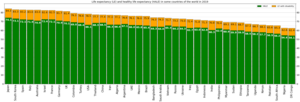


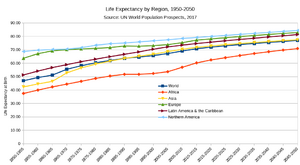
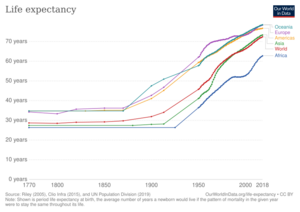
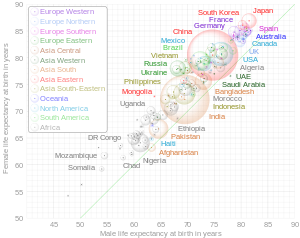
Human life expectancy is a statistical measure of the estimate of the average remaining years of life at a given age. The most commonly used measure is life expectancy at birth (LEB, or in demographic notation e0, where ex denotes the average life remaining at age x). This can be defined in two ways. Cohort LEB is the mean length of life of a birth cohort (in this case, all individuals born in a given year) and can be computed only for cohorts born so long ago that all their members have died. Period LEB is the mean length of life of a hypothetical cohort[1][2] assumed to be exposed, from birth through death, to the mortality rates observed at a given year.[3] National LEB figures reported by national agencies and international organizations for human populations are estimates of period LEB.
Human remains from the early Bronze Age indicate an LEB of 24.[4] In 2019, world LEB was 73.3.[5] A combination of high infant mortality and deaths in young adulthood from accidents, epidemics, plagues, wars, and childbirth, before modern medicine was widely available, significantly lowers LEB. For example, a society with a LEB of 40 would have relatively few people dying at exactly 40: most will die before 30 or after 55. In populations with high infant mortality rates, LEB is highly sensitive to the rate of death in the first few years of life. Because of this sensitivity, LEB can be grossly misinterpreted, leading to the belief that a population with a low LEB would have a small proportion of older people.[6] A different measure, such as life expectancy at age 5 (e5), can be used to exclude the effect of infant mortality to provide a simple measure of overall mortality rates other than in early childhood. For instance, in a society with a life expectancy of 30, it may nevertheless be common to have a 40-year remaining timespan at age 5 (but not a 60-year one).
Aggregate population measures—such as the proportion of the population in various age groups—are also used alongside individual-based measures—such as formal life expectancy—when analyzing population structure and dynamics. Pre-modern societies had universally higher mortality rates and lower life expectancies at every age for both males and females.
Life expectancy, longevity, and maximum lifespan are not synonymous. Longevity refers to the relatively long lifespan of some members of a population. Maximum lifespan is the age at death for the longest-lived individual of a species. Mathematically, life expectancy is denoted [lower-alpha 1] and is the mean number of years of life remaining at a given age , with a particular mortality.[7] Because life expectancy is an average, a particular person may die many years before or after the expected survival.
Life expectancy is also used in plant or animal ecology,[8] and in life tables (also known as actuarial tables). The concept of life expectancy may also be used in the context of manufactured objects,[9] though the related term[dubious ] shelf life is commonly used for consumer products, and the terms "mean time to breakdown" and "mean time between failures" are used in engineering.
History
The earliest documented work on life expectancy was done in the 1660s by John Graunt,[10] Christiaan Huygens, and Lodewijck Huygens.[11]
Human patterns
Maximum
The longest verified lifespan for any human is that of Frenchwoman Jeanne Calment, who is verified as having lived to age 122 years, 164 days, between 21 February 1875 and 4 August 1997. This is referred to as the "maximum life span", which is the upper boundary of life, the maximum number of years any human is known to have lived.[12] A theoretical study shows that the maximum life expectancy at birth is limited by the human life characteristic value δ, which is around 104 years.[13] According to a study by biologists Bryan G. Hughes and Siegfried Hekimi, there is no evidence for limit on human lifespan.[14][15] However, this view has been questioned on the basis of error patterns.[16]
Records of human lifespan above age 100 are highly susceptible to errors.[16] For example, the previous world-record holder for human lifespan, Carrie C. White was uncovered as a simple typographic error after more than two decades.[16][failed verification]
Variation over time
The following information is derived from the 1961 Encyclopædia Britannica and other sources, some with questionable accuracy. Unless otherwise stated, it represents estimates of the life expectancies of the world population as a whole. In many instances, life expectancy varied considerably according to class and gender.
Life expectancy at birth takes account of infant mortality and child mortality but not prenatal mortality.
| Era | Life expectancy at birth in years | Notes |
|---|---|---|
| Paleolithic | 22–33[17] | With modern hunter-gatherer populations' estimated average life expectancy at birth of 33 years, life expectancy for the 60% reaching age 15 averages 39 remaining years.[18] |
| Neolithic | 20[19]–33[20] | Based on Early Neolithic data, life expectancy at age 15 would be 28–33 years.[21] |
| Bronze Age and Iron Age[22] | 26 | Based on Early and Middle Bronze Age data, life expectancy at age 15 would be 28–36 years.[21] |
| Classical Greece[23] | 25[24]–28[25] | Based on Athens Agora and Corinth data, life expectancy at age 15 would be 37–41 years.[21] Most Greeks and Romans died young. About half of all children died before adolescence. Those who survived to the age of 30 had a reasonable chance of reaching 50 or 60. The truly elderly, however, were rare. Because so many died in childhood, life expectancy at birth was probably between 20 and 30 years.[26] |
| Ancient Rome | 20–33 | Data are lacking, but computer models provide the estimate. If a person survived to age 20, they could expect to live around 30 years more. Life expectancy was probably slightly longer for women than men.[31]
Life expectancy at age 1 reached 34-41 remaining years for the 67[27]–75% surviving the first year. For the 55-65% surviving to age 5, remaining life expectancy reached around 40–45,[29] while the ~50% reaching age 10 could expect another 40 years of life.[27] Average remaining years fell to 33-39 at age 15; ~20 at age 40;[27] 14-18 at age 50; ~10–12 at age 60; and ~6–7 at age 70.[29][31] |
| Wang clan of China, 1st century AD – 1749 | 35 | Life expectancy at age 1 reached 47 years for the 72% surviving the first year.[32][33] |
| Early Middle Ages (Europe, from the late 5th or early 6th century to the 10th century) | 30–35 | A Gaulish boy surviving to age 20 might expect to live 25 more years, while a woman at age 20 could normally expect about 17 more years. Anyone who survived until 40 had a good chance of another 15 to 20 years.[34] |
| Pre-Columbian Mesoamerica | 20-40 | Expectation of life at birth 13-36 years for various Pre-Columbian Mesoamerican cultures, most of the results lying in the range 24-32 years.[35] Aztec life expectancy 41.2 years for men and 42.1 for women.[36] |
| Late medieval English peerage[37][38] | 30–33[30] | Around a third of infants died in their first year.[17] Life expectancy at age 10 reached 32.2 remaining years, and for those who survived to 25, the remaining life expectancy was 23.3 years. Such estimates reflected the life expectancy of adult males from the higher ranks of English society in the Middle Ages, and were similar to that computed for monks of the Christ Church in Canterbury during the 15th century.[30] At age 21, life expectancy of an aristocrat was an additional 43 years.[39] |
| 18th-century England [40][17] | 25–40 | For most of the century it ranged from 35 to 40; but in the 1720s it dipped as low as 25.[40] During the second half of the century it averaged 37,[41] while for the elite it passed 40 and approached 50.[32] |
| Pre-Champlain Canadian Maritimes[42] | 60 | |
| 18th-century Prussia[43] | 24.7 | For males.[43] |
| 18th-century France [43] | 27.5–30 | For males:[43] 24.8 years in 1740–1749, 27.9 years in 1750–1759, 33.9 years in 1800–1809.[33] |
| 18th-century American colonies[17] | 28 | Massachusetts colonists who reached the age of 50 could expect to live until 71, and those who were still alive at 60 could expect to reach 75. |
| Beginning of the 19th century[40] | ~29 | At the beginning of the 19th century, no country in the world had a life expectancy at birth longer than 40 years, England, Belgium and the Netherlands came closest, each reaching 40 years by the 1840s (by which time they had been surpassed by Norway, Sweden and Denmark). India's life expectancy is estimated at ~25 years,[40] while Europe averaged ~33 years.[41] |
| Early 19th-century England [22][40][32] | 40 | Remaining years of life averaged ~45[32]–47 for the 84% who survived the first year. Life expectancy fell to ~40 years at age 20, then ~20 years at age 50 and ~10 years at age 70.[40] For a 15-year-old girl it was ~40–45.[44] For the upper-class, LEB rose from ~45 to 50.[32]
Only half of the people born in the early 19th century made it past their 50th birthday. In contrast, 97% of the people born in 21st century England and Wales can expect to live longer than 50 years.[40] |
| 19th-century British India[45] | 25.4 | |
| 19th-century world average[40] | 28.5–32 | Over the course of the century: Europe rose from ~33 to 43, the Americas from ~35 to 41, Oceania ~35 to 48, Asia ~28, Africa 26.[40] In 1820s France, LEB was ~38, and for the 80% that survived, it rose to ~47. For Moscow serfs, LEB was ~34, and for the 66% that survived, it rose to ~36.[32] Western Europe in 1830 was ~33 years, while for the people of Hau-Lou in China, it was ~40.[41] The LEB for a 10-year-old in Sweden rose from ~44 to ~54.[40] |
| 1900 world average[46] | 31–32[40] | Around 48 years in Oceania, 43 in Europe, and 41 in the Americas.[40] Around 47 in the U.S.[17] and around 48 for 15-year-old girls in England.[44] |
| 1950 world average[46] | 45.7–48[40] | Around 60 years in Europe, North America, Oceania, Japan, and parts of South America; but only 41 in Asia and 36 in Africa. Norway led with 72, while in Mali it was merely 26.[40] |
| 2019–2020 world average | 72.6–73.2 [40][47][48] |
|
English life expectancy at birth averaged about 36 years in the 17th and 18th centuries, one of the highest levels in the world although infant and child mortality remained higher than in later periods. Life expectancy was under 25 years in the early Colony of Virginia,[49] and in seventeenth-century New England, about 40% died before reaching adulthood.[50] During the Industrial Revolution, the life expectancy of children increased dramatically.[51] Recorded deaths among children under the age of 5 years fell in London from 74.5% of the recorded births in 1730-49 to 31.8% in 1810-29,[52][53] though this overstates mortality and its fall because of net immigration (hence more dying in the metropolis than were born there) and incomplete registration (particularly of births, and especially in the earlier period). English life expectancy at birth reached 41 years in the 1840s, 43 in the 1870s and 46 in the 1890s, though infant mortality remained at around 150 per thousand throughout this period.
Public health measures are credited with much of the recent increase in life expectancy. During the 20th century, despite a brief drop due to the 1918 flu pandemic,[54] the average lifespan in the United States increased by more than 30 years, of which 25 years can be attributed to advances in public health.[55]
Regional variations
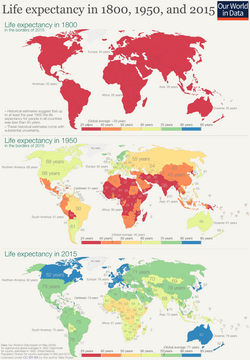
Human beings are expected to live on average 30–40 years in Eswatini[56] and 82.6 years in Japan.[lower-alpha 2] An analysis published in 2011 in The Lancet attributes Japanese life expectancy to equal opportunities, public health, and diet.[58][59]

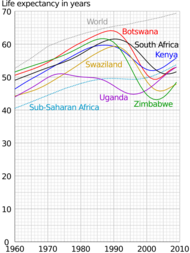
There are great variations in life expectancy between different parts of the world, mostly caused by differences in public health, medical care, and diet. The impact of AIDS on life expectancy is particularly notable in many African countries. According to projections made by the United Nations in 2002, the life expectancy at birth for 2010–2015 (if HIV/AIDS did not exist) would have been:[61]
- 70.7 years instead of 31.6 years, Botswana
- 69.9 years instead of 41.5 years, South Africa
- 70.5 years instead of 31.8 years, Zimbabwe
Actual life expectancy in Botswana declined from 65 in 1990 to 49 in 2000 before increasing to 66 in 2011. In South Africa, life expectancy was 63 in 1990, 57 in 2000, and 58 in 2011. And in Zimbabwe, life expectancy was 60 in 1990, 43 in 2000, and 54 in 2011.[62]
During the last 200 years, African countries have generally not had the same improvements in mortality rates that have been enjoyed by countries in Asia, Latin America, and Europe.[63][64]
In the United States, African-American people have shorter life expectancies than their European-American counterparts. For example, white Americans in 2010 are expected to live until age 78.9, but black Americans only until age 75.1. This 3.8-year gap, however, is the lowest it has been since 1975 at the latest. The greatest difference was 7.1 years in 1993.[65] In contrast, Asian-American women live the longest of all ethnic groups in the United States, with a life expectancy of 85.8 years.[66] The life expectancy of Hispanic-Americans is 81.2 years.[65] According to the new government reports in the US, life expectancy in the country dropped again because of the rise in suicide and drug overdose rates. The Centers for Disease Control (CDC) found nearly 70,000 more Americans died in 2017 than in 2016, with rising rates of death among 25- to 44-year-olds.[67]
Cities also experience a wide range of life expectancy based on neighborhood breakdowns. This is largely due to economic clustering and poverty conditions that tend to associate based on geographic location. Multi-generational poverty found in struggling neighborhoods also contributes. In United States cities such as Cincinnati, the life expectancy gap between low income and high-income neighborhoods touches 20 years.[68]
Economic circumstances
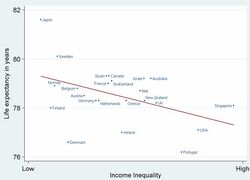
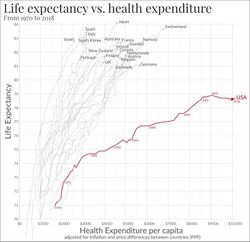
Economic circumstances also affect life expectancy. For example, in the United Kingdom, life expectancy in the wealthiest and richest areas is several years higher than in the poorest areas. This may reflect factors such as diet and lifestyle, as well as access to medical care. It may also reflect a selective effect: people with chronic life-threatening illnesses are less likely to become wealthy or to reside in affluent areas.[71] In Glasgow, the disparity is amongst the highest in the world: life expectancy for males in the heavily deprived Calton area stands at 54, which is 28 years less than in the affluent area of Lenzie, which is only 8 km (5.0 mi) away.[72][73]
A 2013 study found a pronounced relationship between economic inequality and life expectancy.[74] However, in contrast, a study by José A. Tapia Granados and Ana Diez Roux at the University of Michigan found that life expectancy actually increased during the Great Depression, and during recessions and depressions in general.[75] The authors suggest that when people are working at a more extreme degree during prosperous economic times, they undergo more stress, exposure to pollution, and the likelihood of injury among other longevity-limiting factors.
Life expectancy is also likely to be affected by exposure to high levels of highway air pollution or industrial air pollution. This is one way that occupation can have a major effect on life expectancy. Coal miners (and in prior generations, asbestos cutters) often have lower life expectancies than average. Other factors affecting an individual's life expectancy are genetic disorders, drug use, tobacco smoking, excessive alcohol consumption, obesity, access to health care, diet, and exercise.
Sex differences
In the present, female human life expectancy is greater than that of males, despite females having higher morbidity rates (see Health survival paradox). There are many potential reasons for this. Traditional arguments tend to favor sociology-environmental factors: historically, men have generally consumed more tobacco, alcohol, and drugs than women in most societies, and are more likely to die from many associated diseases such as lung cancer, tuberculosis, and cirrhosis of the liver.[77] Men are also more likely to die from injuries, whether unintentional (such as occupational, war, or car wrecks) or intentional (suicide).[77] Men are also more likely to die from most of the leading causes of death (some already stated above) than women. Some of these in the United States include cancer of the respiratory system, motor vehicle accidents, suicide, cirrhosis of the liver, emphysema, prostate cancer, and coronary heart disease.[12] These far outweigh the female mortality rate from breast cancer and cervical cancer. In the past, mortality rates for females in child-bearing age groups were higher than for males at the same age.
A paper from 2015 found that female foetuses have a higher mortality rate than male foetuses.[78] This finding contradicts papers dating from 2002 and earlier that attribute the male sex to higher in-utero mortality rates.[79][80][81] Among the smallest premature babies (those under 2 pounds (910 grams)), females have a higher survival rate. At the other extreme, about 90% of individuals aged 110 are female. The difference in life expectancy between men and women in the United States dropped from 7.8 years in 1979 to 5.3 years in 2005, with women expected to live to age 80.1 in 2005.[82] Data from the United Kingdom shows the gap in life expectancy between men and women decreasing in later life. This may be attributable to the effects of infant mortality and young adult death rates.[83]
Some argue that shorter male life expectancy is merely another manifestation of the general rule, seen in all mammal species, that larger-sized individuals within a species tend, on average, to have shorter lives.[84][85] This biological difference[clarification needed] occurs because women have more resistance to infections and degenerative diseases.[12]
In her extensive review of the existing literature, Kalben concluded that the fact that women live longer than men was observed at least as far back as 1750 and that, with relatively equal treatment, today males in all parts of the world experience greater mortality than females. However, Kalben's study was restricted to data in Western Europe alone, where the demographic transition occurred relatively early. United Nations statistics from mid-twentieth century onward, show that in all parts of the world, females have a higher life expectancy at age 60 than males.[86] Of 72 selected causes of death, only 6 yielded greater female than male age-adjusted death rates in 1998 in the United States. Except for birds, for almost all of the animal species studied, males have higher mortality than females. Evidence suggests that the sex mortality differential in people is due to both biological/genetic and environmental/behavioral risk and protective factors.[87]
One recent suggestion is that mitochondrial mutations which shorten lifespan continue to be expressed in males (but less so in females) because mitochondria are inherited only through the mother. By contrast, natural selection weeds out mitochondria that reduce female survival; therefore, such mitochondria are less likely to be passed on to the next generation. This thus suggests that females tend to live longer than males. The authors claim that this is a partial explanation.[88][89]
Another explanation is the unguarded X hypothesis. According to this hypothesis, one reason for why the average lifespan of males isn't as long as that of females––by 18% on average, according to the study––is that they have a Y chromosome which can't protect an individual from harmful genes expressed on the X chromosome, while a duplicate X chromosome, as present in female organisms, can ensure harmful genes aren't expressed.[90][91]
In developed countries, starting around 1880, death rates decreased faster among women, leading to differences in mortality rates between males and females. Before 1880, death rates were the same. In people born after 1900, the death rate of 50- to 70-year-old men was double that of women of the same age. Men may be more vulnerable to cardiovascular disease than women, but this susceptibility was evident only after deaths from other causes, such as infections, started to decline.[92] Most of the difference in life expectancy between the sexes is accounted for by differences in the rate of death by cardiovascular diseases among persons aged 50–70.[93]
Genetics
The heritability of lifespan is estimated to be less than 10%, meaning the majority of variation in lifespan is attributable due to differences in environment rather than genetic variation.[94] However, researchers have identified regions of the genome which can influence the length of life and the number of years lived in good health. For example, a genome-wide association study of 1 million lifespans found 12 genetic loci which influenced lifespan by modifying susceptibility to cardiovascular and smoking-related disease.[95] The locus with the largest effect is APOE. Carriers of the APOE ε4 allele live approximately one year less than average (per copy of the ε4 allele), mainly due to increased risk of Alzheimer's disease.[95]
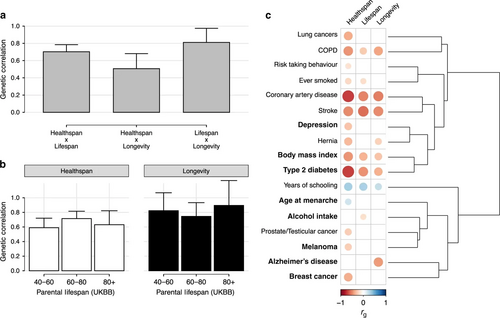
In July 2020, scientists identified 10 genomic loci with consistent effects across multiple lifespan-related traits, including healthspan, lifespan, and longevity.[96] The genes affected by variation in these loci highlighted haem metabolism as a promising candidate for further research within the field. This study suggests that high levels of iron in the blood likely reduce, and genes involved in metabolising iron likely increase healthy years of life in humans.[97]
A follow-up study which investigated the genetics of frailty and self-rated health in addition to healthspan, lifespan, and longevity also highlighted haem metabolism as an important pathway, and found genetic variants which lower blood protein levels of LPA and VCAM1 were associated with increased healthy lifespan.[98]
Centenarians
In developed countries, the number of centenarians is increasing at approximately 5.5% per year, which means doubling the centenarian population every 13 years, pushing it from some 455,000 in 2009 to 4.1 million in 2050.[99] Japan is the country with the highest ratio of centenarians (347 for every 1 million inhabitants in September 2010). Shimane Prefecture had an estimated 743 centenarians per million inhabitants.[100]
In the United States, the number of centenarians grew from 32,194 in 1980 to 71,944 in November 2010 (232 centenarians per million inhabitants).[101]
Mental illness
Mental illness is reported to occur in approximately 18% of the average American population.[102][103]
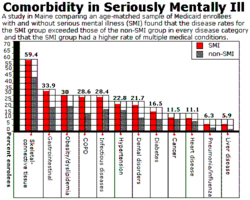
The mentally ill have been shown to have a 10- to 25-year reduction in life expectancy.[105] Generally, the reduction of lifespan in the mentally ill population compared to the mentally stable population has been studied and documented.[106][107][108][109][110]
The greater mortality of people with mental disorders may be due to death from injury, from co-morbid conditions, or medication side effects.[111] For instance, psychiatric medications can increase the risk of developing diabetes.[112][113][114][115] It has been shown that the psychiatric medication olanzapine can increase risk of developing agranulocytosis, among other comorbidities.[116][117] Psychiatric medicines also affect the gastrointestinal tract; the mentally ill have a four times risk of gastrointestinal disease.[118][119][120]
As of 2020 and the COVID-19 pandemic, researchers have found an increased risk of death in the mentally ill.[121][122][123]
Other illnesses
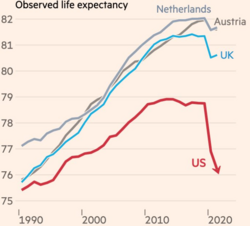
The life expectancy of people with diabetes, which is 9.3% of the U.S. population, is reduced by roughly 10–20 years.[124][125] People over 60 years old with Alzheimer's disease have about a 50% life expectancy of 3–10 years.[126] Other demographics that tend to have a lower life expectancy than average include transplant recipients[127] and the obese.[128]
Education
Education on all levels has been shown to be strongly associated with increased life expectancy.[129] This association may be due partly to higher income,[130] which can lead to increased life expectancy. Despite the association, among identical twin pairs with different education levels, there is only weak evidence of a relationship between educational attainment and adult mortality.[129]
According to a paper from 2015, the mortality rate for the Caucasian population in the United States from 1993 to 2001 is four times higher[dubious ] for those who did not complete high school compared to those who have at least 16 years of education.[129] In fact, within the U.S. adult population, people with less than a high school education have the shortest life expectancies.
Preschool education also plays a large role in life expectancy. It was found that high-quality early-stage childhood education had positive effects on health. Researchers discovered this by analyzing the results of the Carolina Abecedarian Project, finding that the disadvantaged children who were randomly assigned to treatment had lower instances of risk factors for cardiovascular and metabolic diseases in their mid-30s.[131]
Evolution and aging rate
Various species of plants and animals, including humans, have different lifespans. Evolutionary theory states that organisms which—by virtue of their defenses or lifestyle—live for long periods and avoid accidents, disease, predation, etc. are likely to have genes that code for slow aging, which often translates to good cellular repair. One theory is that if predation or accidental deaths prevent most individuals from living to an old age, there will be less natural selection to increase the intrinsic life span.[132] That finding was supported in a classic study of opossums by Austad;[133] however, the opposite relationship was found in an equally prominent study of guppies by Reznick.[134][135]
One prominent and very popular theory states that lifespan can be lengthened by a tight budget for food energy called caloric restriction.[136] Caloric restriction observed in many animals (most notably mice and rats) shows a near doubling of life span from a very limited calorific intake. Support for the theory has been bolstered by several new studies linking lower basal metabolic rate to increased life expectancy.[137][138][139] That is the key to why animals like giant tortoises can live so long.[140] Studies of humans with life spans of at least 100 have shown a link to decreased thyroid activity, resulting in their lowered metabolic rate.Template:No source
The ability of skin fibroblasts to perform DNA repair after UV irradiation was measured in shrew, mouse, rat, hamster, cow, elephant and human.[141] It was found that DNA repair capability increased systematically with species life span. Since this original study in 1974, at least 14 additional studies were performed on mammals to test this correlation.[142] In all, but two of these studies, lifespan correlated with DNA repair levels, suggesting that DNA repair capability contributes to life expectancy.[142]
In a broad survey of zoo animals, no relationship was found between investment of the animal in reproduction and its life span.[143]
Calculation

In actuarial notation, the probability of surviving from age
to age
is denoted
and the probability of dying during age
(i.e. between ages
and
) is denoted
. For example, if 10% of a group of people alive at their 90th birthday die before their 91st birthday, the age-specific death probability at 90 would be 10%. This probability describes the likelihood of dying at that age, and is not the rate at which people of that age die.[lower-alpha 3] It can be shown that
-
()
The curtate future lifetime, denoted , is a discrete random variable representing the remaining lifetime at age , rounded down to whole years. Life expectancy, more technically called the curtate expected lifetime and denoted ,[lower-alpha 1] is the mean of —that is to say, the expected number of whole years of life remaining, assuming survival to age .[144] So,
-
()
Substituting (1) into the sum and simplifying gives the final result [145]
-
()
If the assumption is made that, on average, people live a half year on the year of their death, the complete life expectancy at age would be .
By definition, life expectancy is an arithmetic mean. It can also be calculated by integrating the survival curve from 0 to positive infinity (or equivalently to the maximum lifespan, sometimes called 'omega'). For an extinct or completed cohort (all people born in the year 1850, for example), it can of course simply be calculated by averaging the ages at death. For cohorts with some survivors, it is estimated by using mortality experience in recent years. The estimates are called period cohort life expectancies.
The starting point for calculating life expectancy is the age-specific death rates of the population members. If a large amount of data is available, a statistical population can be created that allow the age-specific death rates to be simply taken as the mortality rates actually experienced at each age (the number of deaths divided by the number of years "exposed to risk" in each data cell). However, it is customary to apply smoothing to remove (as much as possible) the random statistical fluctuations from one year of age to the next. In the past, a very simple model used for this purpose was the Gompertz function, but more sophisticated methods are now used.[146] The most common modern methods include:
- fitting a mathematical formula (such as the Gompertz function, or an extension of it) to the data.
- looking at an established mortality table derived from a larger population and making a simple adjustment to it (such as multiplying by a constant factor) to fit the data. (In cases of relatively small amounts of data.)
- looking at the mortality rates actually experienced at each age and applying a piecewise model (such as by cubic splines) to fit the data. (In cases of relatively large amounts of data.)
The age-specific death rates are calculated separately for separate groups of data that are believed to have different mortality rates (such as males and females, or smokers and non-smokers) and are then used to calculate a life table from which one can calculate the probability of surviving to each age. While the data required are easily identified in the case of humans, the computation of life expectancy of industrial products and wild animals involves more indirect techniques. The life expectancy and demography of wild animals are often estimated by capturing, marking, and recapturing them.[147] The life of a product, more often termed shelf life, is also computed using similar methods. In the case of long-lived components, such as those used in critical applications (e.g. aircraft), methods like accelerated aging are used to model the life expectancy of a component.[9]
The life expectancy statistic is usually based on past mortality experience and assumes that the same age-specific mortality rates will continue. Thus, such life expectancy figures need to be adjusted for temporal trends before calculating how long a currently living individual of a particular age is expected to live. Period life expectancy remains a commonly used statistic to summarize the current health status of a population. However, for some purposes, such as pensions calculations, it is usual to adjust the life table used by assuming that age-specific death rates will continue to decrease over the years, as they have usually done in the past. That is often done by simply extrapolating past trends, but some models exist to account for the evolution of mortality, like the Lee–Carter model.[148]
As discussed above, on an individual basis, some factors correlate with longer life. Factors that are associated with variations in life expectancy include family history, marital status, economic status, physique, exercise, diet, drug use (including smoking and alcohol consumption), disposition, education, environment, sleep, climate, and health care.[12]
Healthy life expectancy
To assess the quality of these additional years of life, 'healthy life expectancy' has been calculated for the last 30 years. Since 2001, the World Health Organization has published statistics called Healthy life expectancy (HALE), defined as the average number of years that a person can expect to live in "full health" excluding the years lived in less than full health due to disease and/or injury.[149][150] Since 2004, Eurostat publishes annual statistics called Healthy Life Years (HLY) based on reported activity limitations. The United States uses similar indicators in the framework of the national health promotion and disease prevention plan "Healthy People 2010". More and more countries are using health expectancy indicators to monitor the health of their population.
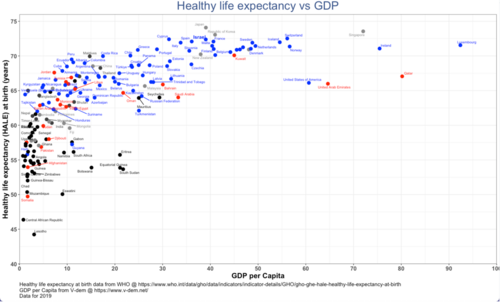
The long-standing quest for longer life led in the 2010s to a more promising focus on increasing HALE, also known as a person's "healthspan". Besides the benefits of keeping people healthier longer, a goal is to reduce health-care expenses on the many diseases associated with cellular senescence. Approaches being explored include fasting, exercise, and senolytic drugs.[151]
Forecasting
Forecasting life expectancy and mortality form an important subdivision of demography. Future trends in life expectancy have huge implications for old-age support programs (like U.S. Social Security and pension) since the cash flow in these systems depends on the number of recipients who are still living (along with the rate of return on the investments or the tax rate in pay-as-you-go systems). With longer life expectancies, the systems see increased cash outflow; if the systems underestimate increases in life-expectancies, they will be unprepared for the large payments that will occur, as humans live longer and longer.
Life expectancy forecasting is usually based on one of two different approaches:
- Forecasting the life expectancy directly, generally using ARIMA or other time-series extrapolation procedures. This has the advantage of simplicity, but it cannot account for changes in mortality at specific ages, and the forecast number cannot be used to derive other life table results. Analyses and forecasts using this approach can be done with any common statistical/mathematical software package, like EViews, R, SAS, Stata, Matlab, or SPSS.
- Forecasting age-specific death rates and computing the life expectancy from the results with life table methods. This is usually more complex than simply forecasting life expectancy because the analyst must deal with correlated age-specific mortality rates, but it seems to be more robust than simple one-dimensional time series approaches. It also yields a set of age-specific rates that may be used to derive other measures, such as survival curves or life expectancies at different ages. The most important approach in this group is the Lee-Carter model,[152] which uses the singular value decomposition on a set of transformed age-specific mortality rates to reduce their dimensionality to a single time series, forecasts that time series, and then recovers a full set of age-specific mortality rates from that forecasted value. The software includes Professor Rob J. Hyndman's R package called 'demography' and UC Berkeley's LCFIT system.
Policy uses
Life expectancy is one of the factors in measuring the Human Development Index (HDI) of each nation along with adult literacy, education, and standard of living.[153]
Life expectancy is used in describing the physical quality of life of an area. It is also used for an individual when the value of a life settlement is determined a life insurance policy is sold for a cash asset.[clarification needed]
Disparities in life expectancy are often cited as demonstrating the need for better medical care or increased social support. A strongly associated indirect measure is income inequality. For the top 21 industrialized countries, if each person is counted equally, life expectancy is lower in more unequal countries (r = −0.907).[154] There is a similar relationship among states in the U.S. (r = −0.620).[155]
Life expectancy vs. other measures of longevity
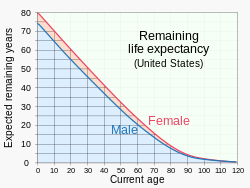
Life expectancy may be confused with the average age an adult could expect to live, creating the misunderstanding that an adult's lifespan would be unlikely to exceed their life expectancy at birth, even though having already avoided succumbing to childhood mortality, an adult will always outlive the lifespan calculated from their birth. One may compare the life expectancy of the period after childhood to estimate also the life expectancy of an adult.[157]
As a measure of the years of life remaining, life expectancy decreases with age after initially rising in early childhood, but the average age to which a person is likely to live increases as they survive to successive higher ages.[158] In the table above, the estimated modern hunter-gatherer average expectation of life at birth of 33 years (often considered an upper-bound for Paleolithic populations) equates to a life expectancy at 15 of 39 years, so that those surviving to age 15 will on average die at 54.
In England in the 13th-19th centuries with life expectancy at birth rising from perhaps 25 years to over 40, expectation of life at age 30 has been estimated at around 20-30 years,[159] giving an average age at death of about 50-60 for those (a minority at the start of the period but two-thirds at its end) surviving beyond their twenties.

The table above gives the life expectancy at birth among 13th-century English nobles as 30-33, but having surviving to the age of 21, a male member of the English aristocracy could expect to live:
- 1200–1300: to age 64
- 1300–1400: to age 45 (because of the bubonic plague)
- 1400–1500: to age 69
- 1500–1550: to age 71 [39]
A further concept is that of modal age at death, the single age when deaths among a population are more numerous than at any other age. In all pre-modern societies the most common age at death is the first year of life: it is only as infant mortality falls below around 33-34 per thousand (roughly a tenth of estimated ancient and medieval levels) that deaths in a later year of life (usually around age 80) become more numerous. While the most common age of death in adulthood among modern hunter-gatherers (often taken as a guide to the likely most favourable Paleolithic demographic experience) is estimated to average 72 years,[160] the number dying at that age is dwarfed by those (over a fifth of all infants) dying in the first year of life, and only around a quarter usually survive to the higher age.
Maximum life span is an individual-specific concept, and therefore is an upper bound rather than an average.[157] Science author Christopher Wanjek writes, "[H]as the human race increased its life span? Not at all. This is one of the biggest misconceptions about old age: we are not living any longer." The maximum life span, or oldest age a human can live, may be constant.[157] Further, there are many examples of people living significantly longer than the average life expectancy of their time period, such as Socrates (71), Saint Anthony the Great (105), Michelangelo (88), and John Adams (90).[157]
However, anthropologist John D. Hawks criticizes the popular conflation of life span (life expectancy) and maximum life span when popular science writers falsely imply that the average adult human does not live longer than their ancestors. He writes, "[a]ge-specific mortality rates have declined across the adult lifespan. A smaller fraction of adults die at 20, at 30, at 40, at 50, and so on across the lifespan. As a result, we live longer on average... In every way we can measure, human lifespans are longer today than in the immediate past, and longer today than they were 2000 years ago... age-specific mortality rates in adults really have reduced substantially."[161]
See also
- Biodemography
- Calorie restriction
- Demography
- Depreciation
- DNA damage theory of aging
- Glasgow effect
- Health equity
- Life extension
- Life table
- Lindy effect
- List of countries by life expectancy
- List of countries by past life expectancy
- List of longest-living organisms
- LGBT life expectancy
- Maximum life span
- Medieval demography
- Mitohormesis
- Mortality rate
- Population pyramid
- Senescence
Increasing life expectancy
- Strategies for engineered negligible senescence (SENS)
- John Sperling
- Life extension
- Longevity
- Rejuvenation
- Public health
- Infant mortality
Notes
- ↑ 1.0 1.1 In standard actuarial notation, ex refers to the expected future lifetime of (x) in whole years, while eͦx (with a ring above the e) denotes the complete expected future lifetime of (x), including the fraction.
- ↑ Japan's recorded life expectancy may have been very slightly increased by counting many infant deaths as stillborn.[57]
- ↑ Note the different units: a probability is unit-less, whereas a mortality rate has units (such as deaths per population per year).
References
- ↑ ""Life Expectancy" – What does this actually mean?". https://ourworldindata.org/life-expectancy-how-is-it-calculated-and-how-should-it-be-interpreted.
- ↑ "Period and cohort life expectancy explained: December 2019 – Office for National Statistics". https://www.ons.gov.uk/peoplepopulationandcommunity/birthsdeathsandmarriages/lifeexpectancies/methodologies/periodandcohortlifeexpectancyexplained.
- ↑ S. Shryock, J. S. Siegel et al. The Methods, and Materials of Demography. Washington, DC, US Bureau of the Census, 1973
- ↑ MacLennan WJ, Sellers WI. Ageing through the Ages. Journal of the Royal College of Physicians of Edinburgh. 1999;29(1):71-75. doi:10.1177/147827159902900114
- ↑ World Health Organization 2023 data.who.int, Life expectancy at birth (years) [Indicator] https://data.who.int/indicators/i/90E2E48 (Accessed on 18 December 2023)
- ↑ Laden, Greg (2011-05-01). "Falsehood: "If this was the Stone Age, I'd be dead by now"". ScienceBlogs. http://scienceblogs.com/gregladen/2011/05/01/falsehood-if-this-was-the-ston/.
- ↑ Arthur O'Sullivan; Steven M. Sheffrin (2003). Economics: Principles in Action. Pearson Prentice Hall. p. 473. ISBN 978-0-13-063085-8.
- ↑ John S. Millar; Richard M. Zammuto (1983). "Life Histories of Mammals: An Analysis of Life Tables". Ecology (Ecological Society of America) 64 (4): 631–635. doi:10.2307/1937181. Bibcode: 1983Ecol...64..631M.
- ↑ 9.0 9.1 Eliahu Zahavi, Vladimir Torbilo & Solomon Press (1996) Fatigue Design: Life Expectancy of Machine Parts. CRC Press. ISBN 978-0-8493-8970-2.
- ↑ Sutherland, Ian (15 July 2005). "Graunt, John". Encyclopedia of Biostatistics. pp. 1–2. doi:10.1002/0470011815.b2a17055. ISBN 978-0-470-84907-1.
- ↑ Johnson, Steven (2021) (in en). Extra Life (1st ed.). Riverhead Books. pp. 15. ISBN 978-0-525-53885-1.
- ↑ 12.0 12.1 12.2 12.3 Santrock, John (2007). Life Expectancy. A Topical Approach to: Life-Span Development (pp. 128–132). New York, New York: The McGraw-Hill Companies, Inc.
- ↑ X. Liu (2015). "Life equations for the senescence process". Biochemistry and Biophysics Reports 4: 228–233. doi:10.1016/j.bbrep.2015.09.020. PMID 29124208.
- ↑ "No detectable limit to how long people can live" (Press release). Science Daily. June 28, 2017. Retrieved July 4, 2017.
- ↑ Hughes, Bryan G.; Hekimi, Siegfried (June 29, 2017). "Many possible maximum lifespan trajectories". Nature 546 (7660): E8–E9. doi:10.1038/nature22786. PMID 28658230. Bibcode: 2017Natur.546E...8H.
- ↑ 16.0 16.1 16.2 Newman, Saul Justin (2018-12-20). "Errors as a primary cause of late-life mortality deceleration and plateaus" (in en). PLOS Biology 16 (12): e2006776. doi:10.1371/journal.pbio.2006776. ISSN 1545-7885. PMID 30571676.
- ↑ 17.0 17.1 17.2 17.3 17.4 17.5 Kotre, John N.; Hall, Elizabeth (1997). Seasons of Life: The Dramatic Journey from Birth to Death. University of Michigan Press. pp. 47–49. ISBN 978-0-472-08512-5. https://books.google.com/books?id=b7hiKxl9jZ4C&pg=PA47.
- ↑ Hillard Kaplan; Kim Hill; Jane Lancaster; A. Magdalena Hurtado (2000). "A Theory of Human Life History Evolution: Diet, Intelligence and Longevity". Evolutionary Anthropology 9 (4): 156–185. doi:10.1002/1520-6505(2000)9:4<156::AID-EVAN5>3.0.CO;2-7. http://www.unm.edu/~hkaplan/KaplanHillLancasterHurtado_2000_LHEvolution.pdf. Retrieved 12 September 2010.
- ↑ "The Neolithic Revolution and Contemporary Variations in Life Expectancy". Brown University Working Paper. 2007. http://www.brown.edu/academics/economics/sites/brown.edu.academics.economics/files/uploads/2007-14_paper.pdf.
- ↑ Angel Lawrence J. (1984), "Health as a crucial factor in the changes from hunting to developed farming in the eastern Mediterranean", Proceedings of Meeting on Paleopathology at the Origins of Agriculture: 51–73
- ↑ 21.0 21.1 21.2 J. Lawrence Angel (May 1969). "The bases of paleodemography". American Journal of Physical Anthropology 30 (3): 427–437. doi:10.1002/ajpa.1330300314. PMID 5791021.
- ↑ 22.0 22.1 "Natural Selection and the Evolution of Life Expectancy". Brown University Working Paper. 2005. http://sticerd.lse.ac.uk/seminarpapers/dg09102006.pdf.
- ↑ Morris, Ian (2004). "Economic Growth in Ancient Greece". Journal of Institutional and Theoretical Economics 160 (4): 709–742. doi:10.1628/0932456042776050.
- ↑ Mogens Herman Hansen, The Shotgun Method, p. 55.
- ↑ "Mortality". Britannica.com. https://www.britannica.com/EBchecked/topic/393100/mortality. Retrieved November 4, 2010.
- ↑ 26.0 26.1 Ryan, Garrett (2021-09-01). Naked Statues, Fat Gladiators, and War Elephants: Frequently Asked Questions about the Ancient Greeks and Romans. Rowman & Littlefield. p. 44. ISBN 978-1-63388-703-9. https://books.google.com/books?id=sFkzEAAAQBAJ&pg=PA44.
- ↑ 27.0 27.1 27.2 27.3 Boatwright, Mary T. (2021). Imperial Women of Rome: Power, Gender, Context. Oxford University Press. p. 87. ISBN 978-0-19-045589-7. https://books.google.com/books?id=W78lEAAAQBAJ&pg=PA87.
- ↑
- Scheidel, Walter (2017). Debating Roman Demography. BRILL. p. 29. ISBN 978-90-04-35109-7. https://books.google.com/books?id=EgD1DwAAQBAJ&pg=PA29. "25-30"
- Flower, Harriet I. (2014). The Cambridge Companion to the Roman Republic. Cambridge University Press. p. 105. ISBN 978-1-139-99238-1. https://books.google.com/books?id=MzH6AwAAQBAJ&pg=PA105.
- Scheidel, Walter (2006). "Growing up fatherless in antiquity: the demographic background". Princeton/Stanford Working Papers in Classics: 2. https://www.princeton.edu/~pswpc/pdfs/scheidel/060601.pdf.
- Wolf, Arthur P. (2005). Inbreeding, Incest, and the Incest Taboo: The State of Knowledge at the Turn of the Century. Stanford University Press. p. 97. ISBN 978-0-8047-5141-4. https://books.google.com/books?id=OW1nuQxcIQgC&pg=PA97.
- ↑ 29.0 29.1 29.2 Saller, Richard P. (1997). Patriarchy, Property and Death in the Roman Family. Cambridge University Press. pp. 22–25. ISBN 978-0-521-59978-8. https://books.google.com/books?id=_VbZEvtcGbMC&pg=PA23.
- ↑ 30.0 30.1 30.2 Carrieri, Maria Patrizia; Serraino, Diego (2005-12-01). "Longevity of popes and artists between the 13th and the 19th century". International Journal of Epidemiology 34 (6): 1435–1436. doi:10.1093/ije/dyi211. PMID 16260451. https://academic.oup.com/ije/article/34/6/1435/707557.
- ↑ 31.0 31.1 Frier, Bruce (2009). "Chapter 27: Demographics". The Cambridge Ancient History XI: The High Empire, A.D. 70–192. Cambridge University Press. pp. 788–789. ISBN 978-1-139-05439-3.
- ↑ 32.0 32.1 32.2 32.3 32.4 32.5 Maher, George (2021). The Imperial Roman Economy. Kilnamanagh. pp. 123, 137, 123–151. ISBN 978-1-9996262-2-8. https://books.google.com/books?id=iqAlEAAAQBAJ&pg=PA123.
- ↑ 33.0 33.1 Bagchi, Amiya Kumar (2008). Perilous Passage: Mankind and the Global Ascendancy of Capital. Rowman & Littlefield Publishers. p. 138. ISBN 978-1-4617-0515-4. https://books.google.com/books?id=xHsHEoYh3V0C&pg=PA138.
- ↑ Bitel, Lisa M. (2002-10-24). Women in Early Medieval Europe, 400-1100. Cambridge University Press. ISBN 978-0-521-59773-9. https://books.google.com/books?id=XRudk_NcA7cC&pg=PA25.
- ↑ McCaa, Robert. "The Peopling of Mexico from Origins to Revolution" (in en). https://users.pop.umn.edu/~rmccaa/mxpoprev/cambridg3.htm.
- ↑ Krause, Stanford Mc (in en). Life in the Aztec Empire. Brainy Bookstore Mckrause. https://books.google.com/books?id=kwCqDwAAQBAJ.
- ↑ "Time traveller's guide to Medieval Britain". Channel4.com. http://www.channel4.com/history/microsites/H/history/guide12/part06.html.
- ↑ "A millennium of health improvement". BBC News. December 27, 1998. http://news.bbc.co.uk/1/hi/health/241864.stm.
- ↑ 39.0 39.1 "Expectations of Life" by H.O. Lancaster (page 8)
- ↑ 40.00 40.01 40.02 40.03 40.04 40.05 40.06 40.07 40.08 40.09 40.10 40.11 40.12 40.13 40.14 Roser, Max; Ortiz-Ospina, Esteban; Ritchie, Hannah (2019). "Life Expectancy". Our World in Data (How did life expectancy change over time?). https://ourworldindata.org/life-expectancy#how-did-life-expectancy-change-over-time.
- ↑ 41.0 41.1 41.2 Li, Bozhong (2021). An Early Modern Economy in China. Cambridge University Press. pp. 246–247. ISBN 978-1-108-47920-2. https://books.google.com/books?id=h7H2DwAAQBAJ&pg=PA247.
- ↑ Francis, Daniel (2006). Voices and Visions: A Story of Canada. Canada: Oxford University Press. pp. 21. ISBN 978-0-19-542169-9.
- ↑ 43.0 43.1 43.2 43.3 Cite error: Invalid
<ref>tag; no text was provided for refs namedpomeranz - ↑ 44.0 44.1 Cite error: Invalid
<ref>tag; no text was provided for refs namedGriffin2008 - ↑ "Life expectancy". Our World in Data. https://ourworldindata.org/grapher/life-expectancy?year=1810.
- ↑ 46.0 46.1 Prentice, Thomson. "Health, history and hard choices: Funding dilemmas in a fast-changing world". https://www.who.int/global_health_histories/seminars/presentation07.pdf.
- ↑
72.6
- U.N. Department of Economic and Social Affairs, Population Division. "World Population Prospects 2019". https://population.un.org/wpp/Publications/Files/WPP2019_Highlights.pdf.
- ↑ 48.0 48.1 "Life Expectancy by Country and in the World - Worldometer". https://www.worldometers.info/demographics/life-expectancy/.
- ↑ "[1]", Stratfordhall.org.
- ↑ "Death in Early America ". Digital History.
- ↑ "Modernization – Population Change". Encyclopædia Britannica.
- ↑ Mabel C. Buer, Health, Wealth and Population in the Early Days of the Industrial Revolution, London: George Routledge & Sons, 1926, page 30 ISBN 978-0-415-38218-2
- ↑ BBC—History—The Foundling Hospital. Published: May 1, 2001.
- ↑ "Gapminder World". http://www.gapminder.org/world/#$majorMode=chart$is;shi=t;ly=2003;lb=f;il=t;fs=11;al=30;stl=t;st=t;nsl=t;se=t$wst;tts=C$ts;sp=5.59290322580644;ti=1918$zpv;v=0$inc_x;mmid=XCOORDS;iid=phAwcNAVuyj1jiMAkmq1iMg;by=ind$inc_y;mmid=YCOORDS;iid=phAwcNAVuyj2tPLxKvvnNPA;by=ind$inc_s;uniValue=8.21;iid=phAwcNAVuyj0XOoBL_n5tAQ;by=ind$inc_c;uniValue=255;gid=CATID0;by=grp$map_x;scale=log;dataMin=194;dataMax=96846$map_y;scale=lin;dataMin=23;dataMax=86$map_s;sma=49;smi=2.65$cd;bd=0$inds=;modified=75.
- ↑ CDC (1999). "Ten great public health achievements—United States, 1900–1999". MMWR Morb Mortal Wkly Rep 48 (12): 241–3. PMID 10220250. http://cdc.gov/mmwr/preview/mmwrhtml/00056796.htm. Reprinted in: "From the Centers for Disease Control and Prevention. Ten great public health achievements—United States, 1900–1999". JAMA 281 (16): 1481. 1999. doi:10.1001/jama.281.16.1481. PMID 10227303.
- ↑ "The World Factbook — Central Intelligence Agency". November 4, 2021. https://www.cia.gov/the-world-factbook/countries/eswatini/.
- ↑ Ansley J. Coale; Judith Banister (December 1996). "Five decades of missing females in China". Proceedings of the American Philosophical Society 140 (4): 421–450. Also printed as "Five decades of missing females in China.". Demography 31 (3): 459–79. Aug 1994. doi:10.2307/2061752. PMID 7828766. https://zenodo.org/record/1235093.
- ↑ Boseley, Sarah (August 30, 2011). "Japan's life expectancy 'down to equality and public health measures'". The Guardian (London). https://www.theguardian.com/world/2011/aug/30/japan-life-expectancy-factors. "Japan has the highest life expectancy in the world but the reasons says an analysis, are as much to do with equality and public health measures as diet.... According to a paper in a Lancet series on healthcare in Japan...."
- ↑ Ikeda, Nayu; Saito, Eiko; Kondo, Naoki; Inoue, Manami; Ikeda, Shunya; Satoh, Toshihiko; Wada, Koji; Stickley, Andrew et al. (August 2011). "What has made the population of Japan healthy?". The Lancet 378 (9796): 1094–105. doi:10.1016/S0140-6736(11)61055-6. PMID 21885105. http://www.thelancet.com/journals/lancet/article/PIIS0140-6736(11)61055-6/abstract. "Reduction in health inequalities with improved average population health was partly attributable to equal educational opportunities and financial access to care.".
- ↑ "Life expectancy at birth, total (years)—Data". http://data.worldbank.org/indicator/SP.DYN.LE00.IN/countries/1W.
- ↑ ""World Population Prospects—The 2002 Revision", 2003, page 24". https://www.un.org/ESA/population/publications/wpp2002/WPP2002-HIGHLIGHTSrev1.PDFUN.
- ↑ "GHO—By category—Life expectancy—Data by country". http://apps.who.int/gho/data/node.main.688?lang=en.
- ↑ "Wealth & Health of Nations". Gapminder. http://www.gapminder.org/world/#$majorMode=chart$is;shi=t;ly=2003;lb=f;il=t;fs=11;al=30;stl=t;st=t;nsl=t;se=t$wst;tts=C$ts;sp=5.59290322580644;ti=2013$zpv;v=0$inc_x;mmid=XCOORDS;iid=phAwcNAVuyj1jiMAkmq1iMg;by=ind$inc_y;mmid=YCOORDS;iid=phAwcNAVuyj2tPLxKvvnNPA;by=ind$inc_s;uniValue=8.21;iid=phAwcNAVuyj0XOoBL_n5tAQ;by=ind$inc_c;uniValue=255;gid=CATID0;by=grp$map_x;scale=log;dataMin=194;dataMax=96846$map_y;scale=lin;dataMin=23;dataMax=86$map_s;sma=49;smi=2.65$cd;bd=0$inds=;example=75.
- ↑ "Life Expectancy in the U.S. Dropped for the Second Year in a Row in 2021". August 31, 2022. https://www.cdc.gov/nchs/pressroom/nchs_press_releases/2022/20220831.htm.
- ↑ 65.0 65.1 "Deaths: Final Data for 2010", National Vital Statistics Reports, authored by Sherry L. Murphy, Jiaquan Xu, and Kenneth D. Kochanek, volume 61, number 4, page 12, 8 May 2013
- ↑ United States Department of Health and Human Services, Office of Minority Health—Asian American/Pacific Islander Profile . Retrieved October 1, 2013.
- ↑ "Drug and suicide deaths rise as US life expectancy drops". BBC News. November 30, 2018. https://www.bbc.com/news/world-us-canada-46389147.
- ↑ "The Root Causes of Poverty". Waterfields. http://waterfieldsllc.com/about-waterfields/social-mission/root-causes-poverty/.
- ↑ Wilkinson, Richard; Kate Pickett (2009). The Spirit Level: Why Greater Equality Makes Societies Stronger. Bloomsbury Press. ISBN 978-1-60819-036-2. https://archive.org/details/spiritlevelwhygr0000wilk.
- ↑ Link between health spending and life expectancy: US is an outlier. May 26, 2017. By Max Roser at Our World in Data. Click the sources tab under the chart for info on the countries, healthcare expenditures, and data sources. See the later version of the chart here.
- ↑ Department of Health—Tackling health inequalities : Status report on the Programme for Action
- ↑ "Social factors key to ill health". BBC News. August 28, 2008. http://news.bbc.co.uk/1/hi/health/7584056.stm#Life%20expectancy.
- ↑ "GP explains life expectancy gap". BBC News. August 28, 2008. http://news.bbc.co.uk/1/hi/scotland/glasgow_and_west/7584450.stm.
- ↑ Fletcher, Michael A. (March 10, 2013). "Research ties economic inequality to gap in life expectancy". Washington Post. https://www.washingtonpost.com/business/economy/research-ties-economic-inequality-to-gap-in-life-expectancy/2013/03/10/c7a323c4-7094-11e2-8b8d-e0b59a1b8e2a_story.html.
- ↑ "Did The Great Depression Have A Silver Lining? Life Expectancy Increased By 6.2 Years". September 29, 2009. https://www.sciencedaily.com/releases/2009/09/090928172530.htm.
- ↑ PELE, Laurent. "How long will I live? Estimate remaining life expectancy for all countries in the world". http://smart-unit-converter.com/life-expectancy.php.
- ↑ 77.0 77.1 World Health Organization (2004). "Annex Table 2: Deaths by cause, sex and mortality stratum in WHO regions, estimates for 2002". The world health report 2004 – changing history. https://www.who.int/entity/whr/2004/annex/topic/en/annex_2_en.pdf.
- ↑ "The human sex ratio from conception to birth" Steven Hecht Orzack, J. William Stubblefield, Viatcheslav R. Akmaev, Pere Colls, Santiago Munné, Thomas Scholl, David Steinsaltz, and James E. Zuckerman PNAS April 21, 2015 112 (16) E2102-E2111; first published March 30, 2015 https://doi.org/10.1073/pnas.1416546112.
- ↑ Kalben, Barbara Blatt. "Why Men Die Younger: Causes of Mortality Differences by Sex". Society of Actuaries", 2002, p. 17.http://www.soa.org/library/monographs/life/why-men-die-younger-causes-of-mortality-differences-by-sex/2001/january/m-li01-1-05.pdf
- ↑ Tatter, Dorothy; Blanc, William A.; Wright, David L.; Burt, Leslie S.; Naeye, Richard L. (1971-12-01). "Neonatal Mortality, the Male Disadvantage" (in en). Pediatrics 48 (6): 902–906. doi:10.1542/peds.48.6.902. ISSN 0031-4005. PMID 5129451. https://pediatrics.aappublications.org/content/48/6/902.
- ↑ Waldron, Ingrid (1983-01-01). "Sex differences in human mortality: The role of genetic factors". Social Science & Medicine 17 (6): 321–333. doi:10.1016/0277-9536(83)90234-4. ISSN 0277-9536. PMID 6344225.
- ↑ Hitti, Miranda (February 28, 2005). "U.S. Life Expectancy Best Ever, Says CDC". eMedicine. WebMD. http://www.webmd.com/healthy-aging/news/20050228/us-life-expectancy-best-ever-says-cdc.
- ↑ "Life expectancy—care quality indicators". Nuffield Trust & Health Foundation. http://www.qualitywatch.org.uk/indicator/life-expectancy#vis-ref_221.
- ↑ "Telemores, sexual size dimorphism and gender gap in life expectancy". Jerrymondo.tripod.com. http://jerrymondo.tripod.com/lgev/id1.html.
- ↑ Samaras Thomas T., Heigh Gregory H.. "How human size affects longevity and mortality from degenerative diseases". Townsend Letter for Doctors & Patients 159 (78–85): 133–139.
- ↑ United Nations, Department of Economic and Social Affairs, Population Division p. 53.. "World Population Ageing 2015 (ST/ESA/SER.A/390)". United Nations. https://www.un.org/en/development/desa/population/publications/pdf/ageing/WPA2015_Report.pdf.
- ↑ Kalben, Barbara Blatt. Why Men Die Younger: Causes of Mortality Differences by Sex Society of Actuaries, 2002.
- ↑ "Fruit flies offer DNA clue to why women live longer". BBC News. August 2, 2012. https://www.bbc.co.uk/news/health-19093442.
- ↑ Evolutionary biologist, PZ Myers Mother's Curse
- ↑ "Why men (and other male animals) die younger: It's all in the Y chromosome" (in en-us). phys.org. https://phys.org/news/2020-03-men-male-animals-die-younger.html.
- ↑ Xirocostas, Zoe A.; Everingham, Susan E.; Moles, Angela T. (25 March 2020). "The sex with the reduced sex chromosome dies earlier: a comparison across the tree of life". Biology Letters 16 (3): 20190867. doi:10.1098/rsbl.2019.0867. PMID 32126186.
- ↑ "When Did Women Start to Outlive Men?". July 6, 2015. http://www.livescience.com/51455-women-outlive-men.html.
- ↑ Hiram Beltrán-Sánchez, Caleb E. Finch, and Eileen M. Crimmins. "Twentieth-century surge of excess adult male mortality." PNAS July 21, 2015 112 (29) 8993–8998; published ahead of print July 6, 2015 https://doi.org/10.1073/pnas.1421942112.
- ↑ Ruby, J.G.; Wright, K.M.; Rand, K.A.; Kermany, A.; Noto, K.; Curtis, D; Varner, N.; Garrigan, D. et al. (November 2018). "Estimates of the Heritability of Human Longevity Are Substantially Inflated due to Assortative Mating". Genetics 210 (3): 1109–1124. doi:10.1534/genetics.118.301613. PMID 30401766.
- ↑ 95.0 95.1 Timmers, P.R.H.J.; Mounier, N.; Lall, K.; Fischer, K.; Ning, Z.; Feng, X.; Bretherick, A.D.; Clark, D.W. et al. (January 2019). "Genomics of 1 million parent lifespans implicates novel pathways and common diseases and distinguishes survival chances". eLife 8 (e39856). doi:10.7554/eLife.39856. PMID 30642433.
- ↑ 96.0 96.1 Timmers, Paul R. H. J.; Wilson, James F.; Joshi, Peter K.; Deelen, Joris (16 July 2020). "Multivariate genomic scan implicates novel loci and haem metabolism in human ageing" (in en). Nature Communications 11 (1): 3570. doi:10.1038/s41467-020-17312-3. ISSN 2041-1723. PMID 32678081. Bibcode: 2020NatCo..11.3570T.
- ↑ "Blood iron levels could be key to slowing ageing, gene study shows" (in en). phys.org. https://phys.org/news/2020-07-blood-iron-key-ageing-gene.html.
- ↑ Timmers, P.R.H.J.; Tiys, E.S.; Sakaue, S.; Akiyama, M.; Kiiskinen, T.T.J.; Zhou, W.; Hwang, S.; Yao, C. et al. (January 2022). "Mendelian randomization of genetically independent aging phenotypes identifies LPA and VCAM1 as biological targets for human aging". Nature Aging 2 (1): 19–30. doi:10.1038/s43587-021-00159-8. PMID 37118362.
- ↑ United Nations "World Population Ageing 2009"; ST/ESA/SER.A/295, Population Division, Department of Economic and Social Affairs, United Nations, New York, Oct. 2010, liv + 73 pp.
- ↑ Japan Times "Centenarians to Hit Record 44,000". The Japan Times, September 15, 2010. Okinawa 667 centenarians per 1 million inhabitants in September 2010, had been for a long time the Japanese prefecture with the largest ratio of centenarians, partly because it also had the largest loss of young and middle-aged population during the Pacific War.
- ↑ "Resident Population. National Population Estimates for the 2000s. Monthly Postcensal Resident Population, by single year of age, sex, race, and Hispanic Origin" , Bureau of the Census (updated monthly). Different figures, based on earlier assumptions (104,754 centenarians on Nov.1, 2009) are provided in "Older Americans Month: May 2010" , Bureau of the Census, Facts for Features, March 2, 2010, 5 pp.
- ↑ "Nearly 1 in 5 Americans Suffers From Mental Illness Each Year". February 28, 2014. http://www.newsweek.com/nearly-1-5-americans-suffer-mental-illness-each-year-230608.
- ↑ Silove, Derrick; Patel, Vikram; Jackson, John W.; Chey, Tien; Iranpour, Changiz; Marnane, Claire; Steel, Zachary (April 2014). "The global prevalence of common mental disorders: A systematic review and meta-analysis 1980–2013". International Journal of Epidemiology 43 (2): 476–493. doi:10.1093/ije/dyu038. PMID 24648481.
- ↑ "Morbidity and Mortality in People With Serious Mental Illness". National Association of State Mental Health Program Directors. 2006. https://www.nasmhpd.org/sites/default/files/Mortality%20and%20Morbidity%20Final%20Report%208.18.08.pdf.
- ↑ Khullar, Dhruv (2018-05-30). "The Largest Health Disparity We Don't Talk About". The New York Times. https://mobile.nytimes.com/2018/05/30/upshot/mental-illness-health-disparity-longevity.html.
- ↑ Wahlbeck, Kristian; Westman, Jeanette; Nordentoft, Merete; Gissler, Mika; Laursen, Thomas Munk (December 1, 2011). "Outcomes of Nordic mental health systems: life expectancy of patients with mental disorders". Br J Psychiatry 199 (6): 453–458. doi:10.1192/bjp.bp.110.085100. PMID 21593516.
- ↑ Reininghaus, Ulrich; Dutta, Rina; Dazzan, Paola; Doody, Gillian A.; Fearon, Paul; Lappin, Julia; Heslin, Margaret; Onyejiaka, Adanna et al. (September 27, 2014). "Mortality in Schizophrenia and Other Psychoses: A 10-Year Follow-up of the ӔSOP First-Episode Cohort". Schizophr Bull 41 (3): 664–73. doi:10.1093/schbul/sbu138. PMID 25262443.
- ↑ "Life expectancy and cardiovascular mortality in persons with schizophrenia.". Curr Opin Psychiatry 25 (2): 83–8. March 2012. doi:10.1097/YCO.0b013e32835035ca. PMID 22249081.
- ↑ "Antipsychotics Linked to Mortality in Parkinson's". http://www.medscape.com/viewarticle/861159.
- ↑ Rosenbaum Lisa (2016). "Closing the Mortality Gap — Mental Illness and Medical Care". New England Journal of Medicine 375 (16): 1585–1589. doi:10.1056/NEJMms1610125. PMID 27797313.
- ↑ "Inquest told there was a "lost opportunity" to treat mental health patient who died following severe constipation". http://www.northamptonchron.co.uk/news/inquest-told-there-was-a-lost-opportunity-to-treat-mental-health-patient-who-died-following-severe-constipation-1-5244246.
- ↑ "Hyperglycemia associated with olanzapine treatment". Indian J Psychiatry 53 (2): 176–7. 2011. doi:10.4103/0019-5545.82562. PMID 21772658.
- ↑ "Lilly Adds Strong Warning Label to Zyprexa, a Schizophrenia Drug". The New York Times. October 6, 2007. https://www.nytimes.com/2007/10/06/business/06zyprexa.html.
- ↑ Codario, Ronald A. (October 28, 2007). Type 2 Diabetes, Pre-Diabetes, and the Metabolic Syndrome. Springer Science & Business Media. ISBN 978-1-59259-932-5. https://books.google.com/books?id=0RDZdDW0EqEC&q=zyprexa%20increase%20the%20chance%20of%20developing%20the%20disease%20of%20diabetes&pg=PA17.
- ↑ "Antipsychotic-Related Metabolic Testing Falls Far Short". MedScape. http://www.medscape.com/viewarticle/863871.
- ↑ Jose Ma. J. Alvir (1993). "Clozapine-Induced Agranulocytosis -- Incidence and Risk Factors in the United States". New England Journal of Medicine 329 (3): 162–167. doi:10.1056/NEJM199307153290303. PMID 8515788.
- ↑ "Zyprexa Prescribing Information". 2010. https://www.accessdata.fda.gov/drugsatfda_docs/label/2010/020592s057,021086s036,021253s045lbl.pdf.
- ↑ Philpott, H L; Nandurkar, S; Lubel, J; Gibson, P R (January 2014). "Drug-induced gastrointestinal disorders". Frontline Gastroenterology 5 (1): 49–57. doi:10.1136/flgastro-2013-100316. ISSN 2041-4137. PMID 28839751.
- ↑ "Life-threatening constipation associated with clozapine". Australas Psychiatry 16 (3): 216–9. 2008. doi:10.1080/10398560701882203. PMID 18568631.
- ↑ "Fatalities associated with clozapine-related constipation and bowel obstruction: a literature review and two case reports". Psychosomatics 50 (4): 416–9. 2009. doi:10.1176/appi.psy.50.4.416. PMID 19687183.
- ↑ "Association of Psychiatric Disorders With Mortality Among Patients With COVID-19". Date January 27 2021. Authors Katlyn Nemani, Chenxiang Li, Mark Olfson. doi:10.1001/jamapsychiatry.2020.4442
- ↑ "Increased risk of COVID-19 infection and mortality in people with mental disorders: analysis from electronic health records in the United States." Date October 7 2020. Authors QuanQiu Wang, Rong Xu, Nora D. Volkow. doi.org/10.1002/wps.20806
- ↑ "Association of a Prior Psychiatric Diagnosis With Mortality Among Hospitalized Patients With Coronavirus Disease 2019 (COVID-19) Infection" Date September 30, 2020 . Authors Luming Li, Fangyong Li, Frank Fortunati. doi:10.1001/jamanetworkopen.2020.23282
- ↑ "Diabetes Life Expectancy – Type 1 and Type 2 Life Expectancy". January 15, 2019. http://www.diabetes.co.uk/diabetes-life-expectancy.html.
- ↑ Centers for Disease Control and Prevention
- ↑ "Life expectancy in Alzheimer's disease (AD)". Archives of Gerontology and Geriatrics 49 (Suppl 1): 237–43. 2009. doi:10.1016/j.archger.2009.09.035. PMID 19836639.
- ↑ Kiberd, Bryce A.; Keough-Ryan, Tammy; Clase, Catherine M. (2003). "Screening for prostate, breast and colorectal cancer in renal transplant recipients". American Journal of Transplantation 3 (5): 619–625. doi:10.1034/j.1600-6143.2003.00118.x. PMID 12752319.
- ↑ Diehr Paula (2008). "Weight, mortality, years of healthy life, and active life expectancy in older adults". Journal of the American Geriatrics Society 56 (1): 76–83. doi:10.1111/j.1532-5415.2007.01500.x. PMID 18031486.
- ↑ 129.0 129.1 129.2 Hummer, Robert A.; Hernandez, Elaine M. (June 2013). "The Effect of Educational Attainment on Adult Mortality in the United States*". Population Bulletin 68 (1): 1–16. ISSN 0032-468X. PMID 25995521.
- ↑ Torpey, Elka. "Measuring the value of education : Career Outlook: U.S. Bureau of Labor Statistics" (in en). https://www.bls.gov/careeroutlook/2018/data-on-display/education-pays.htm.
- ↑ Campbell, Frances & Conti, Gabriella & Heckman, James & Moon, Seong & Pinto, Rodrigo & Pungello, Elizabeth & Pan, Yi. (2014). Early Childhood Investments Substantially Boost Adult Health. Science. 343. 1478–85. 10.1126/science.1248429.
- ↑ Williams G (1957). "Pleiotropy, natural selection, and the evolution of senescence". Evolution (Society for the Study of Evolution) 11 (4): 398–411. doi:10.2307/2406060.
- ↑ Austad SN (1993). "Retarded senescence in an insular population of Virginia opossums". J. Zool. Lond. 229 (4): 695–708. doi:10.1111/j.1469-7998.1993.tb02665.x.
- ↑ "Effect of extrinsic mortality on the evolution of senescence in guppies". Nature 431 (7012): 1095–1099. 2004. doi:10.1038/nature02936. PMID 15510147. Bibcode: 2004Natur.431.1095R.
- ↑ "How can evolutionary theory accommodate recent empirical results on organismal senescence?". Theory in Biosciences 126 (1): 3–8. 2007. doi:10.1007/s12064-007-0001-0. PMID 18087751.
- ↑ Kirkwood TE (1977). "Evolution of aging". Nature 270 (5635): 301–304. doi:10.1038/270301a0. PMID 593350. Bibcode: 1977Natur.270..301K.
- ↑ Hulbert, A. J.; Pamplona, Reinald; Buffenstein, Rochelle; Buttemer, W. A. (October 1, 2007). "Life and Death: Metabolic Rate, Membrane Composition, and Life Span of Animals". Physiol. Rev. 87 (4): 1175–1213. doi:10.1152/physrev.00047.2006. PMID 17928583. http://pdfs.semanticscholar.org/0c1b/ece43845df356bc2dda22dd27a82a8ef95e8.pdf.
- ↑ Olshansky, S J; Rattan, Suresh IS (July 25, 2009). "What Determines Longevity: Metabolic Rate or Stability?". Discovery Medicine 5 (28): 359–362. PMID 20704872. http://www.discoverymedicine.com/S-J-Olshansky/2009/07/25/what-determines-longevity-metabolic-rate-or-stability.
- ↑ Aguilaniu, Hugo; Durieux, Jenni; Dillin, Andrew (October 15, 2005). "Metabolism, ubiquinone synthesis, and longevity". Genes Dev. 19 (20): 2399–2406. doi:10.1101/gad.1366505. PMID 16230529.
- ↑ "The Longevity Secret for Tortoises Is Held In Their Low Metabolism Rate". http://www.immortalhumans.com/the-longevity-secret-for-tortoises-is-held-in-their-low-metabolism-rate/.
- ↑ Hart RW, Setlow RB. Correlation between deoxyribonucleic acid excision-repair and life-span in a number of mammalian species. Proc Natl Acad Sci U S A. 1974 Jun;71(6):2169-73. doi: 10.1073/pnas.71.6.2169. PMID 4526202; PMCID: PMC388412
- ↑ 142.0 142.1 Bernstein, C. and H. Bernstein (1991) Aging, Sex, and DNA Repair, Academic Press, San Diego, CA (see pages 109 - 113)
- ↑ "Lifespan is unrelated to investment in reproduction in populations of mammals and birds in captivity". Ecol. Lett. 10 (10): 867–872. 2007. doi:10.1111/j.1461-0248.2007.01085.x. PMID 17845285. Bibcode: 2007EcolL..10..867R.
- ↑ Kinney, Bill (2019-05-01). "Curtate Expectation of Life" (in en-US). https://infinityisreallybig.com/2019/05/01/curtate-expectation-of-life/.
- ↑ R. Cunningham; T. Herzog; R. London (2008). Models for Quantifying Risk (Third ed.). Actex. ISBN 978-1-56698-676-2. page 92.
- ↑ Anderson, Robert N. (1999) Method for constructing complete annual U.S. life tables. Vital and health statistics. Series 2, Data Evaluation, and methods research; no. 129 (DHHS publication no. (PHS) 99-1329) PDF
- ↑ Linda J Young; Jerry H Young (1998) Statistical ecology: a population perspective. Kluwer Academic Publishers, p. 310
- ↑ Ronald D. Lee and Lawrence Carter. 1992. "Modeling and Forecasting the Time Series of U.S. Mortality", Journal of the American Statistical Association 87 (September): 659–671.
- ↑ "Healthy life expectancy (HALE) at 60 (years)" (in en). World Health Organization. https://www.who.int/data/gho/indicator-metadata-registry/imr-details/healthy-life-expectancy-(hale)-at-60-(years).
- ↑ "Health Status Statistics: Mortality" (in en). World Health Organization. https://www.who.int/healthinfo/statistics/indhale/en/.
- ↑ Lawton, Graham (2019-04-24). Anti-ageing drugs are coming that could keep you healthier for longer. https://www.newscientist.com/article/mg24232270-100-anti-ageing-drugs-are-coming-that-could-keep-you-healthier-for-longer/. Retrieved 2019-05-02.
- ↑ "The Lee-Carter Method for Forecasting Mortality, with Various Extensions and Applications – SOA". SOA. http://www.soa.org/library/journals/north-american-actuarial-journal/2000/january/naaj0001_5.pdf.
- ↑ "International Human Development Indicators—UNDP". Hdrstats.undp.org. http://hdrstats.undp.org/indicators/6.html.
- ↑ De Vogli, R. (2005). "Has the relation between income inequality and life expectancy disappeared? Evidence from Italy and top industrialised countries". Journal of Epidemiology & Community Health 59 (2): 158–162. doi:10.1136/jech.2004.020651. PMID 15650149.
- ↑ Kaplan, G. A; Pamuk, E. R; Lynch, J. W; Cohen, R. D; Balfour, J. L (1996). "Inequality in income and mortality in the United States: analysis of mortality and potential pathways". BMJ 312 (7037): 999–1003. doi:10.1136/bmj.312.7037.999. PMID 8616393.
- ↑ 156.0 156.1 "Actuarial Life Table". U.S. Social Security Administration Office of Chief Actuary. 2020. https://www.ssa.gov/oact/STATS/table4c6.html.
- ↑ 157.0 157.1 157.2 157.3 Wanjek, Christopher (2002), Bad Medicine: Misconceptions and Misuses Revealed, from Distance Healing to Vitamin O, Wiley, pp. 70–71, ISBN 978-0-471-43499-3, https://books.google.com/books?id=oIJ5TKh7mPgC&q=%22this+is+one+of+the+biggest+misconceptions+about+old+age%22&pg=PA70.
- ↑ "Life Expectancy by Age, 1850–2011". http://www.infoplease.com/ipa/A0005140.html.
- ↑ Felinah Memo Hazara Khan-ad-Din. "Old Age, Height and Nutrition: Common Misconceptions About Medieval England". http://sirguillaume.com/wp-content/uploads/2012/01/Old_Age-Height-Nutrition.pdf.
- ↑ Gurven, Michael; Kaplan, Hillard (2007), "Longevity Among Hunter- Gatherers: A Cross-Cultural Examination", Population and Development Review 33 (2): 321–365, doi:10.1111/j.1728-4457.2007.00171.x, https://onlinelibrary.wiley.com/doi/abs/10.1111/j.1728-4457.2007.00171.x
- ↑ Hawks, John (2009), Human lifespans have not been constant for the last 2000 years, http://johnhawks.net/weblog/reviews/life_history/age-specific-mortality-lifespan-bad-science-2009.html.
Further reading
- Leonid A. Gavrilov & Natalia S. Gavrilova (1991), The Biology of Life Span: A Quantitative Approach. New York: Harwood Academic Publisher, ISBN 978-3-7186-4983-9.
- Kochanek, Kenneth D., Elizabeth Arias, and Robert N. Anderson (2013), How Did Cause of Death Contribute to Racial Differences in Life Expectancy in the United States in 2010?. Hyattsville, Md.: U.S. Department of Health and Human Services, Centers for Disease Control and Prevention, National Center for Health Statistics.
External links
- Charts for all countries
- Our World In Data – Life Expectancy—Visualizations of how life expectancy around the world has changed historically (by Max Roser). Includes life expectancy for different age groups. Charts for all countries, world maps, and links to more data sources.
- Global Agewatch has the latest internationally comparable statistics on life expectancy from 195 countries.
- Rank Order—Life expectancy at birth from the CIA's World Factbook.
- Annual Life Tables since 1966; Decennial Life Tables since 1890 from the US Centers for Disease Controls and Prevention, National Center for Health Statistics.
- Life expectancy in Roman times from the University of Texas.
- Animal lifespans: Animal Lifespans from Tesarta Online (Internet Archive); The Life Span of Animals from Dr. Bob's All Creatures Site.
 |
